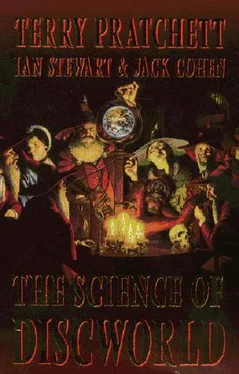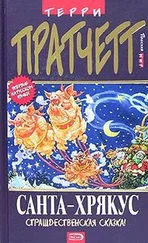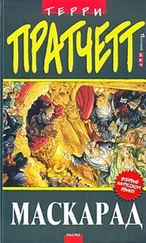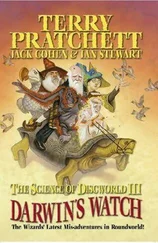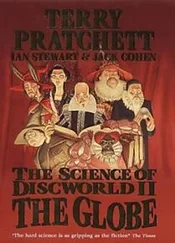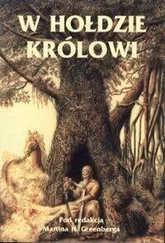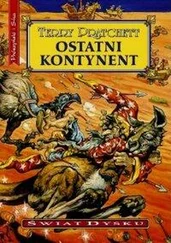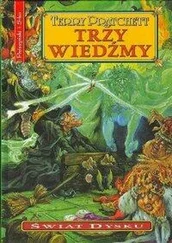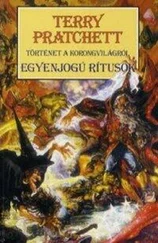Terry Pratchett - Science of Discworld
Здесь есть возможность читать онлайн «Terry Pratchett - Science of Discworld» весь текст электронной книги совершенно бесплатно (целиком полную версию без сокращений). В некоторых случаях можно слушать аудио, скачать через торрент в формате fb2 и присутствует краткое содержание. Жанр: Фантастика и фэнтези, на английском языке. Описание произведения, (предисловие) а так же отзывы посетителей доступны на портале библиотеки ЛибКат.
- Название:Science of Discworld
- Автор:
- Жанр:
- Год:неизвестен
- ISBN:нет данных
- Рейтинг книги:4 / 5. Голосов: 1
-
Избранное:Добавить в избранное
- Отзывы:
-
Ваша оценка:
- 80
- 1
- 2
- 3
- 4
- 5
Science of Discworld: краткое содержание, описание и аннотация
Предлагаем к чтению аннотацию, описание, краткое содержание или предисловие (зависит от того, что написал сам автор книги «Science of Discworld»). Если вы не нашли необходимую информацию о книге — напишите в комментариях, мы постараемся отыскать её.
Science of Discworld — читать онлайн бесплатно полную книгу (весь текст) целиком
Ниже представлен текст книги, разбитый по страницам. Система сохранения места последней прочитанной страницы, позволяет с удобством читать онлайн бесплатно книгу «Science of Discworld», без необходимости каждый раз заново искать на чём Вы остановились. Поставьте закладку, и сможете в любой момент перейти на страницу, на которой закончили чтение.
Интервал:
Закладка:
• Let gravity get in on the act. Now hydrogen and helium collect together to form stars, the wizards' 'furnaces'. At the centre of stars, the pressure is extremely high. This brings new nuclear reactions into play, and you get nuclear fusion, in which atoms become so squashed together that they merge into a new, bigger atom. In this manner, many other familiar elements were formed, from carbon, nitrogen, oxygen, to the less familiar lithium, beryllium and so on up to iron. Many of these elements occur in living creatures, the most important being carbon. For reasons to do with its unique electron structure, carbon is the only atom that can combine with itself to form huge, complex molecules, without which our kind of life would be impossible. Anyway, the point is that most of the atoms from which you are made must have come into being inside a star. As Joni Mitchell sang at Woodstock:: 'We are stardust.' Scientists like quoting this line, because it sounds as though they were young once.
• Wait for some of the stars to explode. There are (comparatively) small explosions called novas, meaning 'new (star)', and more violent ones, supernovas. (What's 'new' is that usually we can't see the star until it explodes, and then we can.) It's not just that the nuclear fuel gets used up: the hydrogen and helium that fuel the star fuse into heavier elements, which in effect become impurities that disturb the nuclear reaction. Pollution is a problem even at the heart of a star. The physics of these early suns changes, and some of the larger ones explode, generating higher elements like iodine, thorium, lead, uranium, and radium. These stars are called 'Population II' by astrophysicists, they are old stars, low in heavy elements, but not lacking them entirely.
• There are two kinds of supernova, and the other type creates heavy elements in abundance, leading to 'Population I' stars, which are much younger than Population II. Because many of these elements have unstable atoms, various other elements are made by their radioactive decay. These 'secondhand' elements include lead.
• Lastly, human beings have made some elements by special arrangements in atomic reactors, the best known being plutonium, a by-product of conventional uranium reactors and a raw material for nuclear weapons. Some rather exotic ones, with very short lifetimes, have been made in experimental atombashers: so far we've got to element 112. Physicists always fight over who got what first and who therefore has the right to propose a name, so at any given time the heaviest elements are likely to have been assigned temporary (and ludicrous) names such as 'ununnilium' for element 110, dog-Latin for '1-1-0-ium'.
What's the point of making extremely short-lived elements like these? You can't use them for anything. Well, like mountains, they are there; moreover, it always helps to test your theories on extreme cases. But the best reason is that they may be steps towards something rather more interesting, assuming that it actually exists. Generally speaking, once you get past polonium at atomic number 84 everything is radioactive, it spits out particles of its own accord and 'decays' into something else, and the greater an element's atomic number, the more rapidly it decays. However, this tendency may not continue indefinitely. We can't model heavy atoms exactly, in fact we can't even model light atoms exactly, but the heavier they are the worse it gets.
Various empirical models (intelligent approximations based on intuition, guesswork, and fiddling adjustable constants) have led to a surprisingly accurate formula for how stable an element should be when it has a given number of protons and a given number of neutrons. For certain 'magic numbers', Roundworld terminology that suggests the physicists concerned have imbibed some of the spirit of Discworld and realized that the formula is closer to a spell than a theory, the corresponding atoms are unusually stable. The magic numbers for protons are 28, 50,82,114, and 164; those for neutrons are 28, 50, 82, 126, 184, 196, and 318. For example the most stable element of all is lead, with 82 protons and 126 neutrons.
Only two steps beyond the incredibly unstable element 112 lies element 114, tentatively named eka-lead. With 114 protons and 184 neutrons it is doubly magic and is therefore likely to be a lot more stable than most elements in its vicinity. The uncertainty arises from worries about the approximations in the stability formula, which may not work for such large numbers. Every wizard is aware that spells can often go wrong. Assuming that the spell works, though, we can play Mendeleev and predict the properties of eka-lead by extrapolating from those in the 'lead' series in the periodic table (carbon, silicon, germanium, tin, lead). As the name suggests, eka-lead turns out to resemble lead, it's expected to be a metal with a melting point of 70°C and a boiling point of 150°C at atmospheric pressure. Its density should be 25% greater than that of lead.
Even further out lies the doubly magic element 164, with 164 protons and 318 neutrons, and beyond that, the magic numbers may continue ... It is always dangerous to extrapolate, but even if the formula is wrong, there could well be certain special configurations of protons and neutrons that are stable enough for the corresponding elements to hang around in the real universe. Perhaps this is where elephantigen and chelonium come from. Possibly Noggo and Plinc await our attention, somewhere. Maybe there are stable elements with vast atomic numbers, some might even be the size of a star. Consider, for instance, a neutron star, one made almost entirely of neutrons, which forms when a larger star collapses under its own gravitational attraction. Neutron stars are incredibly dense: about forty trillion pounds per square inch (100 billion kg/cc), twenty million elephants in a nutshell. They have a surface gravity seven billion times that of the Earth, and a magnetic field a trillion times that of the Earth. The particles in a neutron star are so closely packed that in effect it is one big atom.
Bizarre though they are, some of these superheavy elements may lurk in unusual corners of our universe. In 1968 it was suggested that elements 105-110 could sometimes be observed in cosmic rays, highly energetic particles coming from outer space, but these reports went unconfirmed. It is thought that cosmic rays originate in neutron stars, so maybe in the astonishing conditions found there superheavy elements are formed. What would happen if Population I stars changed by accumulating superheavy stable elements?
Because the stellar population numbers go III, II, I as time passes, a convention that astrophysicists may yet have cause to regret, we must name these hypothetical stars 'Population 0'. At any rate, the future universe could easily contain stellar objects quite different from anything we know about today, and as well as novas and supernovas, we might witness even more energetic explosions, hypernovas. There might even be further stages -Population minus I and the like. As we've said, our universe often seems to make up its rules as it goes along, unlike the rational, stable universe of Discworld.
EAT HOT NAPHTHA, EVIL DOG!
THE ROCKS FELL GENTLY TOGETHER AGAIN, and to the annoyance of the Archchancellor they moved in curved lines while doing so.
'Well, I think we've proved that a giant turtle made of stone isn't going to work,' said the Senior Wrangler, sighing.
'For the tenth time,' sighed the Lecturer in Recent Runes.
'I told you we'd need chelonium,' said Archchancellor Ridcully.
Early attempts spun gently a little way away. Small balls, big balls ... Some of them even had a mantle of gases, pouring out of the clumsy aggregations of ice and rock. It was as if the new universe had some basic idea of what it ought to be, but it couldn't quite manage to get a grip.
Читать дальшеИнтервал:
Закладка:
Похожие книги на «Science of Discworld»
Представляем Вашему вниманию похожие книги на «Science of Discworld» списком для выбора. Мы отобрали схожую по названию и смыслу литературу в надежде предоставить читателям больше вариантов отыскать новые, интересные, ещё непрочитанные произведения.
Обсуждение, отзывы о книге «Science of Discworld» и просто собственные мнения читателей. Оставьте ваши комментарии, напишите, что Вы думаете о произведении, его смысле или главных героях. Укажите что конкретно понравилось, а что нет, и почему Вы так считаете.
